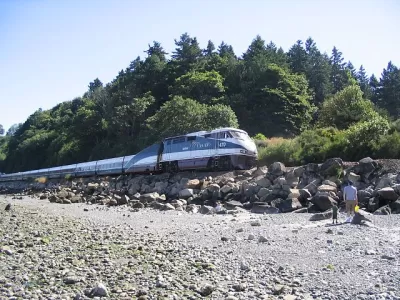Excessive speed is thought to be the cause of the deadly derailment on Dec. 18. Positive train control, which likely would have slowed down the train, was installed on the tracks and locomotive but was not yet operational.

Another deadly passenger train derailment and once again, the spotlight turns to the GPS-enabled railroad safety technology known as positive train control, or PTC, that potentially could have prevented it.
In Monday's fatal crash on a highway overpass above Interstate 5 in Dupont, Wash., 50 miles south of Seattle, Amtrak #501, on its maiden trip for the new Seattle-to-Portland route of the Amtrak Cascades service, was traveling at 80 mph as it entered a curve with a 30 mph speed limit leading into the overpass.
Three people died in the derailment, including rail advocates James Hamre, 61, and Zack Willhoite, 35, his close friend. Over 70 people were injured, which includes those traveling on Interstate 5, one of the busiest highways on the West Coast. The 12-car Talgo train was carrying 80 passengers, five crew members, and one technician.
"The National Transportation Safety Board [NTSB], in preliminary findings based upon event recorder data, identified the cause of the wreck as an overspeed condition," report Stuart Chirls and William C. Vantuono for Railway Age on Dec. 20. "NTSB also cited a lapse in situational awareness [i.e., distraction] on the part of the engineer as a possible contributing factor, as there was a second person in the cab."
Positive Train Control had been installed on the right-of-way, but wasn't operational, said Geoff Patrick, spokesman for Sound Transit, which owns the right-of-way.
The locomotive, as well as the tracks, must be equipped with the GPS technology for it to work to prevent derailments and crashes. According to Washington State Department of Transportation, which administered locomotive acquisition for the Bypass of Point Defiance project, the new Siemens Charger locomotives were equipped with PTC and would be used "once the system is activated corridor-wide in 2018."
"The Amtrak Cascades train service is jointly owned by the Washington State Department of Transportation and the Oregon Department of Transportation," according to WSDOT. "Amtrak operates the service for the two states as a contractor, and is responsible for day to day operations."
[Monday] was the first day of public use of the tracks, after weeks of inspection and testing.
"To date, Amtrak has equipped 49% of its locomotives and control cars, according to Federal Railroad Administration data from the second quarter of 2017," add Chirls and Vantuono for Railway Age.
Monday's derailment comes after several high-profile derailments involving passenger rail. According to Michael Sisak and Michael Balsamo of The Associated Press, PTC had the potential to prevent at least 25 crashes over the last 20 years, including:
- Sept. 29, 2016: One dead after a New Jersey Transit train crashes into Hoboken Terminal. NTSB determined that the engineer had accelerated the train.
- May 6, 2015: Eight deaths in Amtrak 188 derailment outside of Philadelphia. Loss of situational awareness was determined to be the chief cause by NTSB.
- Dec. 1, 2013: Four deaths on a Metro-North commuter train near Spuyten Duyvil in the Bronx.
The thrust of the AP piece is that Amtrak, and presumably its partner agencies, Washington State Department of Transportation and Oregon Department of Transportation, were in too much of a rush to begin service on the new route, potentially to meet deadlines set by the American Recovery and Reinvestment Act of 2009 for funding the $180.7 million bypass project.
WSDOT is investing nearly $800 million of ARRA High Speed High-Speed Intercity Passenger Rail funds throughout the state.
Railroads, both freight and passenger, are required to have PTC installed by "December 31, 2018, with the possibility for two additional years if certain requirements are met," according to the Federal Railroad Administration.
Hat tips to Clyde Anderson and Los Angeles County Metropolitan Transportation Authority Research Library & Archive:
FULL STORY: UPDATED DEC. 20: Overspeed cause of Amtrak Cascades fatal derailment

Planetizen Federal Action Tracker
A weekly monitor of how Trump’s orders and actions are impacting planners and planning in America.

Restaurant Patios Were a Pandemic Win — Why Were They so Hard to Keep?
Social distancing requirements and changes in travel patterns prompted cities to pilot new uses for street and sidewalk space. Then it got complicated.

Map: Where Senate Republicans Want to Sell Your Public Lands
For public land advocates, the Senate Republicans’ proposal to sell millions of acres of public land in the West is “the biggest fight of their careers.”

Maui's Vacation Rental Debate Turns Ugly
Verbal attacks, misinformation campaigns and fistfights plague a high-stakes debate to convert thousands of vacation rentals into long-term housing.

San Francisco Suspends Traffic Calming Amidst Record Deaths
Citing “a challenging fiscal landscape,” the city will cease the program on the heels of 42 traffic deaths, including 24 pedestrians.

California Homeless Arrests, Citations Spike After Ruling
An investigation reveals that anti-homeless actions increased up to 500% after Grants Pass v. Johnson — even in cities claiming no policy change.
Urban Design for Planners 1: Software Tools
This six-course series explores essential urban design concepts using open source software and equips planners with the tools they need to participate fully in the urban design process.
Planning for Universal Design
Learn the tools for implementing Universal Design in planning regulations.
Heyer Gruel & Associates PA
JM Goldson LLC
Custer County Colorado
City of Camden Redevelopment Agency
City of Astoria
Transportation Research & Education Center (TREC) at Portland State University
Camden Redevelopment Agency
City of Claremont
Municipality of Princeton (NJ)


























